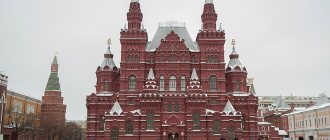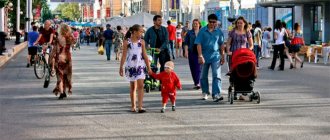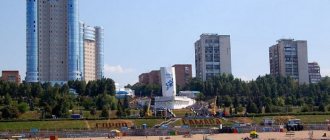The Central Federal District (CFD) is a specific zone belonging to the Russian Federation, which is located in the west of the country. This territory was allocated as a separate district on May 13, 2000 by decree of the President of the Russian Federation. A characteristic feature of the district is that it does not have a single republic. It consists exclusively of cities and regions, as well as a city of federal significance - Moscow. It is also the main administrative center of the district, its “brain”.
The Central Federal District is a district that does not have access to the country’s waters. Despite this, it is considered one of the largest in the Russian Federation in terms of the number of cities and population included in its composition.
Geography
The area of the Central Federal District is 650,205 km2, which is 3.8% of the entire area of Russia. If we compare this district with European countries, it is larger than Ukraine, which is considered the largest among the western neighbors of the Russian Federation. Located entirely on the East European Plain. Includes such hills as Valdai, Central Russian, Smolensk-Moscow. There are also lowlands: Oksko-Donskaya, Meshcherskaya.
Rice.
1. Central Federal District The highest point is considered to be the top of Valdai, which is 347 meters above sea level.
In the west, the Central Federal District borders on Belarus, in the southwest - on Ukraine. This applies to external borders. If we consider the internal border territories, then the southern part borders on the Southern Federal District, in the eastern part - on the Volga District, on the northern side - on the Northwestern Federal District. The number of people living here at the beginning of 2022 is 39,318.0 thousand people, which is 26.77% of the total population of the country. With a density of 60.5 people. km2. The largest rivers in Russia - the Volga, Oka, Don, Western Dvina - flow through the territory of the Central Federal District. There are such natural areas as:
- Mixed forests
- Forests with broadleaf trees
- Steppe zones
- Forest-steppe territories
Rice. 2. Red Square
District map
For convenience, a map of the district indicating regions and administrative centers is presented in the form of a table:
Central regions of Russia on the map
| Name of the region | Area of the region in km² | Population of the region, thousand | Number of city districts | Number of municipalities districts | Number of urban settlements | Number of rural settlements | Admin. center | Population admin. Center, thousand |
| Smolenskaya | 49800 | 949 | 2 | 25 | 23 | 300 | Smolensk | 330 |
| Tverskaya | 84100 | 1283 | 11 | 32 | 40 | 221 | Tver | 420 |
| Yaroslavskaya | 36177 | 1265 | 3 | 17 | 10 | 70 | Yaroslavl | 609 |
| Kostromskaya | 60211 | 643 | 6 | 24 | 12 | 134 | Kostroma | 277 |
| Ivanovskaya | 21800 | 1014 | 6 | 21 | 24 | 92 | Ivanovo | 406 |
| Vladimirskaya | 29000 | 1378 | 5 | 16 | 26 | 80 | Vladimir | 357 |
| Moscow | 2561 | 12615 | 12 | 125 | 21 | — | Moscow | 12615 |
| Moscow | 44300 | 7503 | 53 | 14 | 61 | 78 | Balashikha | 468 |
| Smolenskaya | 49800 | 949 | 2 | 25 | 23 | 300 | Smolensk | 330 |
| Bryansk | 34900 | 1210 | 6 | 27 | 30 | 226 | Bryansk | 405 |
| Kaluzhskaya | 29800 | 1012 | 2 | 24 | 28 | 258 | Kaluga | 340 |
| Tula | 25700 | 1491 | 7 | 19 | 23 | 54 | Tula | 482 |
| Ryazan | 39600 | 1212 | 4 | 25 | 29 | 24 | Ryazan | 540 |
| Tambovskaya | 34300 | 1033 | 7 | 23 | 13 | 234 | Tambov | 293 |
| Lipetskaya | 24100 | 1150 | 2 | 18 | 6 | 288 | Lipetsk | 509 |
| Orlovskaya | 24700 | 747 | 3 | 24 | 17 | 223 | Eagle | 315 |
| Kursk | 29800 | 1115 | 5 | 28 | 27 | 295 | Kursk | 448 |
| Belgorodskaya | 27100 | 1549 | 3 | 19 | 25 | 265 | Belgorod | 391 |
| Voronezh | 52216 | 2333 | 3 | 31 | 29 | 471 | Voronezh | 1054 |
Natural resources
This federal district has the most iron ore minerals. Their main deposits are located in the Kursk magnetic anomaly. According to statistics, this anomaly ranks first in the world ranking in terms of geological reserves.
However, iron ore is not the only thing the Central Federal District is rich in. Large deposits of such resources as:
- Chalk
- Limestone
- Fireproof clay
- Marl
- Glass and molding sand
If we consider the resources intended for use as fuel (fuel and energy complex), then most of them are expressed in the form of brown coal in the Moscow region. It even spreads in areas such as:
- Tverskaya
- Kaluzhskaya
- Ryazan
- Smolenskaya
There are peat deposits in the Kostroma and Yaroslavl regions.
Rice. 3. Yaroslavl tire plant
List of subjects of the Central Federal District:
| Subject | Center | Population million people | Area sq.km |
| Moscow | 12,3 | 2511 | |
| Ivanovo region | Ivanovo | 1,023 | 21437 |
| Lipetsk region | Lipetsk | 1,156 | 24047 |
| Oryol Region | Eagle | 0,755 | 24652 |
| Tula region | Tula | 1,49 | 25679 |
| Belgorod region | Belgorod | 1,55 | 27134 |
| Vladimir region | Vladimir | 1,39 | 29084 |
| Kaluga region | Kaluga | 1,016 | 29777 |
| Kursk region | Kursk | 1,123 | 29997 |
| Tambov Region | Tambov | 1,039 | 34462 |
| Bryansk region | Bryansk | 1,22 | 34857 |
| Yaroslavl region | Yaroslavl | 1,27 | 36177 |
| Ryazan Oblast | Ryazan | 1,12 | 39605 |
| Moscow region | Moscow | 7,43 | 44379 |
| Smolensk region | Smolensk | 0,95 | 49779 |
| Voronezh region | Voronezh | 2,3 | 52216 |
| Kostroma region | Kostroma | 0,65 | 60211 |
| Tver region | Tver | 1,3 | 84201 |
Agro-industrial complex (AIC)
More than 33 thousand hectares are provided for agriculture in the Central Federal District. Thanks to the fertile soils, most of which are podzolic and sod-podzolic, crops such as:
- Wheat
- Rye
- Oats
- Barley
- Buckwheat
The livestock sector of the agro-industrial complex is no less well developed. In particular, these are meat and dairy animals, pig farming, poultry farms, and sheep farms. Honey production and fish farming occupy a special position.
Rice. 4. Main building of Voronezh State University
Demographics of Voronezh
At the beginning of the 20th century, the population of this city did not exceed 70 thousand people. The rapid growth of this city in Central Russia began during a period of active urbanization - immediately after the end of the civil war. By the early nineties, the population reached 900 thousand, but in the 2000s there was a downward trend again.
It is worth noting that even though it was not officially a million-plus city, Voronezh formed an agglomeration with a population of 1.3 million people. Voronezh received official status as a city with a population of one million on December 17, 2012.
Transport network
The Central Federal District is one of the districts in which there are absolutely all types of transport routes: railway, road, underground, aviation, water and others. In total, the structure of the transport network is as follows:
- 70 main railway junctions
. The most important among them and throughout Russia is the Moscow Transport Hub (MTU). - 28 airports of various aviation types
. This does not take into account especially large ones, such as Sheremetyevo, because they are located in the zone of direct influence of Moscow. - More than 17,000 km of railway lines
. - The total length of
paved highways is more than 227,000 kilometers. - The length of waterways
within the district is 5.5 thousand km. Although the district does not have direct access to the waters of the seas and oceans, thanks to several river networks, ships from the Central Federal District can go to both the Baltic and the Caspian, White, Azov, and Black Seas.
The Central Federal District has international transport routes, such as the Trans-Siberian Railway, which goes straight to Vladivostok.
Important! The Central Federal District also has several oil pipelines, oil product pipelines, and a main gas pipeline.
Inland waters
The reservoirs of Central Russia play a huge role in the formation of unique relief and natural features. In addition, settlements were formed around large rivers and lakes from ancient times, which have now grown into large cities - Moscow, Voronezh, Yaroslavl, Kursk, Orel, Tula, Lipetsk, Kaluga, Vladimir, Ivanovo.
Deep rivers flow through Central Russia, which are important not only for Russia, but also for neighboring countries. On the territory of the districts there are basins of the Volga (the largest tributary of the Oka), the Dnieper (a tributary is the Desna River), the Don (2 tributaries - the Khoper River and the Northern Donets River) and the Western Dvina. Another important tributary of the Oka is the Moksha River.
The following rivers are considered navigable: Volga, Oka, Moscow, Don, Dnieper, Sura, Vyatka and Vetluga. Many of them have access to the seas (Baltic, Caspian and Black). With the growth of cities and settlements in the Central regions, there is a shortage of water. Therefore, it is so important to create and properly operate both artificial and natural reservoirs.
The largest artificial reservoir is Rybinsk in the Yaroslavl region. Its area is 4580 km² and its water volume is 25.4 km³. They began to build it on the bed of the Volga River in 1935, for this purpose they resettled and flooded 663 settlements. But it was completely filled only in 1947.
Now the Rybinsk Reservoir has important economic and natural significance: energy production (Rybinsk State Power Plant with a capacity of 356 MW), fishing and shipping, as well as protected areas (Darwin Nature Reserve).
Along with Rybinsk, the district has several other large reservoirs:
- Verkhnevolzhskoye in Tverskots region.
- Ivankovskoye in the Moscow region.
- Uglichskoe in the Yaroslavl region.
- Yauzskoe in the Smolensk region.
The district is rich in lakes. The largest include Seliger (Tver and Novgorod regions), Lake Galichskoye (Kostroma region), lakes Nero and Pleshcheyevo (Yaroslavl region) and Lake Volgo (Tver region).
In the north of the district there are numerous swamps and wetlands. The largest in area are in the Tver region. These are the well-known Upper Volga swamp complex and the Zharkovsko-Svitskie swamps, as well as the Orsha moss. The total area of marshes and wetlands in the county is more than 12,000 km².
Another amazing creation of man is an artificial canal that connects 2 rivers - the Volga and Moscow. The canal has a length of 128 km, runs through the Tver region, along the Moscow region and partially covers the capital. The canal supplies Moscow with 60% industrial and drinking water.
Market infrastructure
The development of the market system in the Central Federal District is 5 steps ahead of all other districts and regions. In this regard, it accounts for 14.6% of all-Russian indicators. In the Central Federal District, according to the latest statistics from Russian analysts, there is a high rate of development, reaching 25%. As for taxes that are paid directly to the federal budget, then the mark crosses the threshold of 45%.
Rice. 5. Moscow Refinery
Moscow is a multimillionaire city
In Russia, only two cities deserve multimillionaire status (that is, cities with a population of more than five million people) - Moscow and St. Petersburg. Moreover, the capital crossed this milestone already in 1959.
Starting from the second half of the 19th century, when the population of Moscow was 800,000 people, the number of its inhabitants only increased. And due to the newly acquired status of the capital, the growth rate has rapidly increased.
Thus, already in 2000 the population of the capital exceeded the mark of ten million people. To what extent such rapid growth is beneficial for the urban environment and the people already living in it is an open question, however, experts note that in terms of the method of reproduction and growth rate, Moscow is close to European capitals, but in terms of population density it is more likely to approach overpopulated Asian centers demonstrating explosive growth in the last two decades.
Industry
All industries are highly developed in the Central Federal District. Based on this, the following statistics were made, reflecting the general indicators and level of academic performance in relation to other constituent entities of the Russian Federation. Let's look at specific data using the example of the Moscow region:
- Metal processing accounts for almost 39% of all-Russian indicators
- Electric power industry - 11%
- Construction production - 11.3%
- Food industry - 9.1%
- Light industry - 10%
- Khimprom - almost 8%
- The woodworking industry accounts for - 5%
- Non-ferrous metallurgy about 3.5%
- Ferrous metallurgy - 2.3%
Mechanical engineering
Mechanical engineering occupies a major position in the Central Federal District. Recently, the machine tool industry, aircraft manufacturing, electrical power equipment, electrical appliances and carriage building have become particularly widespread. The main center of this field of activity is the capital of the Russian Federation - Moscow. The main ZIL enterprise, which produces trucks, is located here. There are numerous enterprises producing machine tools for all types of industries: food, textile, woodworking and others.
Population
Of the total population of almost 39 million people, there are many different nationalities in the Central Federal District - there are about 28 of them. Let's look at the nations that make up the bulk:
- Russians make up the bulk of the population - 89.10%
- Representatives of Ukraine - 1.34%
- Armenian citizens - 0.71%
- Tatars - 0.69%
Due to such a wide national composition, there are 9 language groups, which are united into 7 families:
- Indo-European family consisting of Slavs, Armenians, Iranians, Romanians, Indo-European Jews and Indo-Aryans. The main part, naturally, is occupied by representatives of the Slavic family - more than 90%.
- The Altai family includes the Turks and Mongols.
- Ural family consisting of a Finno-Ugric group.
- North Caucasian family.
- Kartvelian family.
- Korean family.
- Semitic-Hamitic family.








